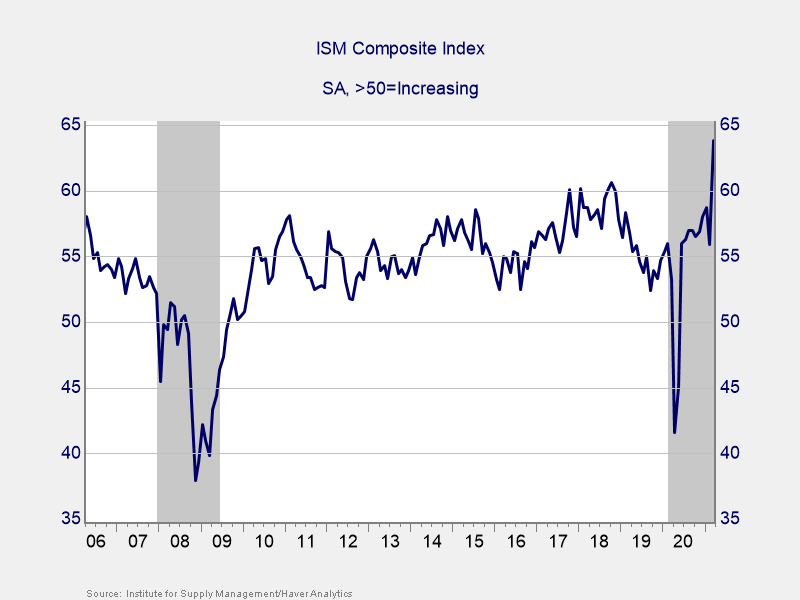Markets Rally as Economic Recovery Accelerates
April was a strong month for U.S. equity markets, with the three major indices setting all-time highs. The Dow Jones Industrial Average gained 2.78 percent, and the S&P 500 saw a 5.34 percent increase. The Nasdaq Composite led the way with a strong 5.43 percent gain.
April’s better-than-expected earnings reports also helped boost markets. According to Bloomberg Intelligence, as of April 30 with 60.4 percent of companies having reported, the blended first-quarter earnings growth rate for the S&P 500 stands at 45.9 percent. This is significantly better than analyst estimates for a 23.9 percent growth rate.
Technical factors also remained supportive for markets in April. All three major U.S. indices remained above their respective 200-day moving averages. This marks 10 straight months where the indices have finished the month above trend.
International markets also saw gains during the month. The MSCI EAFE Index increased by 3.01 percent. The MSCI Emerging Markets Index saw a bit more volatility but managed to end April with a 2.50 percent gain. Both international indices remained above their respective 200-day moving averages.
Fixed income markets had a positive April, driven by moderating long-term interest rates. The 10-year Treasury yield ended the month at 1.65 percent, down from 1.74 percent at the end of March. The Bloomberg Barclays U.S. Aggregate Bond Index gained 0.79 percent.
High-yield fixed income, which is less tied to interest rate movements and more aligned with equity markets, also had a positive month. The Bloomberg Barclays U.S. Corporate High Yield Index gained 1.09 percent. High-yield spreads continued to compress in April, ending the month at their lowest level since October 2018.
Increase in Vaccinations Supports Positive Public Health Trend
Although we’ve seen progress on the public health front this year, March showed an uptick in case growth. This raised concerns about a potential fourth wave of the virus. Encouragingly, April saw a return to lower case counts, with the average number of new cases hitting a 2021 low by month-end.
The improving public health situation shows the positive impact from increased vaccinations. We finished April with more than 43 percent of the population having received at least one dose of a vaccine, and more than 30 percent of the population has now been fully vaccinated. Looking forward, the primary concern is the recent slowdown in the vaccination rate. Ultimately, though, the longer-term trend remains positive.
Economic Recovery Picks Up Steam
The economic news released during the month showed signs of increased activity, driven by continued reopening efforts and the most recent round of federal stimulus checks. After March’s growth in the pace of hiring, April saw declining initial unemployment claims. This was an encouraging sign that the improvements with the economy and public health continued to support a faster labor market recovery.
Consumer confidence is now back near pre-pandemic levels. March’s retail sales and personal spending reports both came in above expectations. The retail sales report was especially encouraging—the 9.8 percent rise in sales was the second-largest monthly increase on record. Businesses saw improved confidence and increased spending. As you can see in Figure 1, the ISM Composite index of business confidence surged in March, bringing the index to its highest level since records began in 1997.
Figure 1. ISM Composite, 2006–Present

Home builder confidence remained high in April, and the pace of new home construction and sales picked up in March. Housing starts and new home sales both reached levels not seen since 2006. Home builders continue to ramp up the pace of construction to meet high levels of home buyer demand, despite rising material and labor costs.
Risks Remain as Recovery Continues
We’ve made significant progress, but the risks to the ongoing recovery remain. The economy appears poised for growth, though, which should support a return to normal once we get the pandemic brought under control. With that said, the pace and path of the recovery are still uncertain. A well-diversified portfolio that matches investor goals to timelines remains the best path forward for most. If concerns remain, contact us to discuss your financial plan.
All information according to Bloomberg, unless stated otherwise.
Disclosure: Certain sections of this commentary contain forward-looking statements based on our reasonable expectations, estimates, projections, and assumptions. Forward-looking statements are not guarantees of future performance and involve certain risks and uncertainties, which are difficult to predict. Past performance is not indicative of future results. Diversification does not assure a profit or protect against loss in declining markets. All indices are unmanaged and investors cannot invest directly into an index. The Dow Jones Industrial Average is a price-weighted average of 30 actively traded blue-chip stocks. The S&P 500 Index is a broad-based measurement of changes in stock market conditions based on the average performance of 500 widely held common stocks. The Nasdaq Composite Index measures the performance of all issues listed in the Nasdaq Stock Market, except for rights, warrants, units, and convertible debentures. The MSCI EAFE Index is a float-adjusted market capitalization index designed to measure developed market equity performance, excluding the U.S. and Canada. The MSCI Emerging Markets Index is a market capitalization-weighted index composed of companies representative of the market structure of 26 emerging market countries in Europe, Latin America, and the Pacific Basin. It excludes closed markets and those shares in otherwise free markets that are not purchasable by foreigners. The Bloomberg Barclays Aggregate Bond Index is an unmanaged market value-weighted index representing securities that are SEC-registered, taxable, and dollar-denominated. It covers the U.S. investment-grade fixed-rate bond market, with index components for a combination of the Bloomberg Barclays government and corporate securities, mortgage-backed pass-through securities, and asset-backed securities. The Bloomberg Barclays U.S. Corporate High Yield Index covers the USD-denominated, non-investment-grade, fixed-rate, taxable corporate bond market. Securities are classified as high-yield if the middle rating of Moody’s, Fitch, and S&P is Ba1/BB+/BB+ or below.





